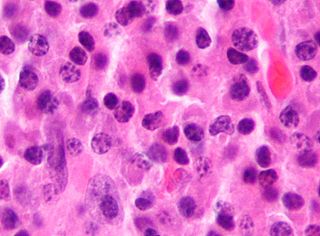
Leukemia, also spelled leukaemia, is a group of blood cancers that usually begin in the bone marrow and result in high numbers of abnormal blood cells. These blood cells are not fully developed and are called blasts or leukemia cells. Symptoms may include bleeding and bruising problems, feeling tired, fever, and an increased risk of infections. These symptoms occur due to a lack of normal blood cells. Diagnosis is typically made by blood tests or bone marrow biopsy.
Monocytosis is an increase in the number of monocytes circulating in the blood. Monocytes are white blood cells that give rise to macrophages and dendritic cells in the immune system.

Tumors of the hematopoietic and lymphoid tissues or tumours of the haematopoietic and lymphoid malignancies are tumors that affect the blood, bone marrow, lymph, and lymphatic system. As those elements are all intimately connected through both the circulatory system and the immune system, a disease affecting one will often affect the others as well, making myeloproliferation and lymphoproliferation closely related and often overlapping problems.
Acute leukemia or acute leukaemia is a family of serious medical conditions relating to an original diagnosis of leukemia. In most cases, these can be classified according to the lineage, myeloid or lymphoid, of the malignant cells that grow uncontrolled, but some are mixed and for those such an assignment is not possible.

Pentostatin is an anticancer chemotherapeutic drug.
Chronic leukemia is an increase of abnormal white blood cells. It differs from acute leukemia, and is categorized as myelogenous or lymphocytic.
α-Naphthyl butyrate esterase, also referred to as naphthyl butyrate esterase or butyrate esterase, is a histological stain specific for white blood cells of the monocytic proliferation line.
THP-1 is a human monocytic cell line derived from an acute monocytic leukemia patient. It is used to test leukemia cell lines in immunocytochemical analysis of protein-protein interactions, and immunohistochemistry.

Acute myeloblastic leukemia with maturation (M2) is a subtype of acute myeloid leukemia (AML).
Chronic neutrophilic leukemia (CNL) is a rare myeloproliferative neoplasm that features a persistent neutrophilia in peripheral blood, myeloid hyperplasia in bone marrow, hepatosplenomegaly, and the absence of the Philadelphia chromosome or a BCR/ABL fusion gene.
A B-cell leukemia is any of several types of lymphoid leukemia which affect B cells.
Accelerated phase chronic myelogenous leukemia is a phase of chronic myelogenous leukemia in which the disease is progressing. In this phase, 10 to 19 % of the cells in the blood and bone marrow are blast cells. In the accelerated phase, these leukemia cells grow quickly.
ICD-10 is an international statistical classification used in health care and related industries.
Hematologic diseases are disorders which primarily affect the blood. Hematology includes the study of these disorders.
Acute eosinophilic leukemia (AEL) is a rare subtype of acute myeloid leukemia with 50 to 80 percent of eosinophilic cells in the blood and marrow. It can arise de novo or may develop in patients having the chronic form of a hypereosinophilic syndrome. Patients with acute eosinophilic leukemia have a propensity for developing bronchospasm as well as symptoms of the acute coronary syndrome and/or heart failure due to eosinophilic myocarditis and eosinophil-based endomyocardial fibrosis. Hepatomegaly and splenomegaly are more common than in other variants of AML.
Leukostasis is a medical emergency most commonly seen in patients with acute myeloid leukemia. It is characterized by an extremely elevated blast cell count and symptoms of decreased tissue perfusion. The pathophysiology of leukostasis is not well understood, but inadequate delivery of oxygen to the body's cells is the end result. Leukostasis is diagnosed when white cell plugs are seen in the microvasculature. The most common symptoms are dyspnea and hypoxia, usually accompanied by visual changes, headaches, dizziness, confusion, somnolence, and coma. Prompt treatment is indicated since, if left untreated, it has a very high mortality rate. Treatments aim to rapidly reduce white blood cell counts while also treating the underlying disorder.
Lenzilumab (INN) is a humanized monoclonal antibody that targets colony stimulating factor 2 (CSF2)/granulocyte-macrophage colony stimulating factor (GM-CSF) designed for the treatment of chronic myelomonocytic leukemia (CMML) and juvenile myelomonocytic leukemia (JMML). In vitro studies on human cells have demonstrated that Lenzilumab can induce sensitivity in myeloid and monocytic cells suggesting the antibody's applicability in CMML and JMML indications.





